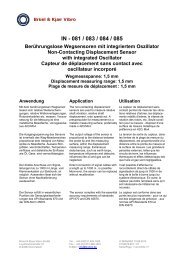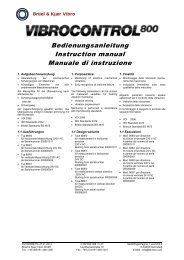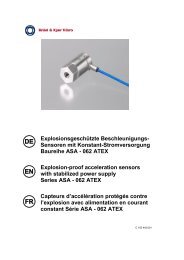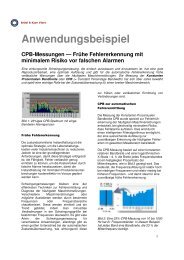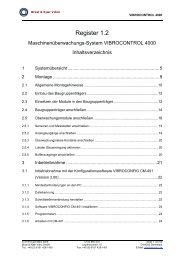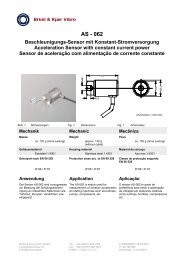Allgemeine Erdungsempfehlung General grounding ...
Allgemeine Erdungsempfehlung General grounding ...
Allgemeine Erdungsempfehlung General grounding ...
Create successful ePaper yourself
Turn your PDF publications into a flip-book with our unique Google optimized e-Paper software.
Warum können Bezugspotentiale<br />
unterschiedlich<br />
sein?<br />
Im allgemeinen wird nicht nur der<br />
zentrale Bezugspunkt, also z.B. der<br />
Erdungspunkt an einer Transformatorstation,<br />
als Bezugspotential<br />
bezeichnet, sondern auch alle mit<br />
diesem direkt verbundenen Rückleiter<br />
und Sammelschienen, sowie<br />
zusätzlich eingerichtete Erder.<br />
Da alle diese Verbindungen - auch die<br />
Erde - sowohl ohmschen, induktiven<br />
als auch kapazitiven Widerstand<br />
besitzen und normalerweise die Rückströme<br />
der Verbraucher hin zur<br />
Versorgung führen, kommt es auf ihrer<br />
gesamten Länge zu Spannungsfällen,<br />
die einem Potentialgefälle gleichzusetzen<br />
sind. Die Abweichung des<br />
lokalen Bezugspotentials vom<br />
zentralen Bezugspunkt hängt also von<br />
der Stromstärke und dem Widerstand<br />
des jeweiligen Rückleiters ab.<br />
Abbildung 4 zeigt an einem einfachen<br />
Beispiel die oben beschriebenen<br />
Zusammenhänge bei der Verwendung<br />
einer Bezugspotential-Sammelschiene.<br />
Abbildung 5 zeigt die<br />
entsprechende Darstellung, wenn als<br />
Rückleiter die Erde benutzt wird.<br />
Abb. 4 Beispiel für das Gefälle des<br />
Bezugspotentials<br />
Why can reference potentials<br />
differ?<br />
In general not only the central<br />
reference point, e.g. the ground point<br />
in a transformer station, is designated<br />
as the reference potential, but<br />
everything connected with the same<br />
return line and bus-bar, as well as<br />
additionally established grounds.<br />
Because all these connections -<br />
including the earth - possess ohmic,<br />
induc-tive or capacitive resistance,<br />
and normally the return current from<br />
the users is fed back to the supply,<br />
this results in a voltage drop over the<br />
entire length of the network which is<br />
equivalent to the potential drop. The<br />
difference in potential between the<br />
local reference potential and the<br />
central reference point is dependent<br />
therefore on the strength of the current<br />
and the resistance of the respective<br />
return line.<br />
Figure 4 illustrates an example of the<br />
above described relationship in the<br />
case of a reference potential bus-bar.<br />
Figure 5 shows the corresponding<br />
diagram when the earth is used as the<br />
return line.<br />
Fig. 4: Example for the drop in<br />
reference potential<br />
Erdung Grounding Tierra<br />
Porqué pueden diferir<br />
potenciales de referencia?<br />
En general no es sólo el punto de<br />
referencia central, por ejemplo, el<br />
punto de tierra en una estación<br />
transformadora, que es designado<br />
como el potencial de referencia, sino<br />
que todo lo conectado con la misma<br />
línea de retorno y barra-ómnibus,<br />
como así también tierra adicionalmente<br />
establecida.<br />
Debido a que todas estas conexiones<br />
- inclusive el suelo - poseen<br />
resistencia óhmica, inductiva o<br />
capacitiva y, normalmente, la corriente<br />
de retorno, procedente de los<br />
usuarios, es retroalimentada al<br />
suministro, esto resulta en una caída<br />
de voltaje sobre la longitud total de la<br />
red eléctrica lo que es equivalente a la<br />
caída de potencial. Por consiguiente,<br />
la diferencia de potencial entre el<br />
potencial local de referencia y el punto<br />
central de referencia, son dependientes<br />
de la fuerza de la corriente y<br />
de la resistencia de la línea de retorno<br />
respectiva.<br />
La Figura 4 ilustra un ejemplo de la<br />
correlación de lo arriba descrito en el<br />
caso de una barra-ómnibus de<br />
potencial de referencia. La Figura 5<br />
muestra el diagrama correspondiente<br />
cuando el suelo es utilizado como la<br />
línea de retorno.<br />
Fig.e 4: Ejemplo de la caída en<br />
potencial de referencia<br />
© Erdung DESP 12.4.2006 Seite/Page 23 von/of/de 26



